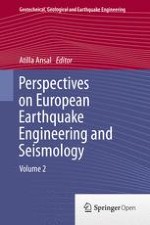17.1 Introduction
17.2 Quantitative Evidence of Nonlinear Behavior of Soils
17.2.1 Spectral Amplification Factors (SAF) Dependence of Magnitude
Earthquake | amax(cm/s2) (recorded) | Sa
max (β = 5 %) | Sa
max/amax (SAF) | Sa
* (elastic)/Sa
max (record) | Sa
*(g) (β = 5 %) | a* as elastic | % |
|---|---|---|---|---|---|---|---|
August 30, 1986 (M
W = 7.1) | 72.20 | 292 cm/s2
| 4.0443 | 1.457 | 425.44 | 105.19 | 45.7 % |
May 30, 1990 (M
W = 6.9) | 132.43 | 684 cm/s2
| 5.1649 | 1.141 | 780.44 | 151.10 | 24.1 % |
May 31, 1990 (M
W = 6.4) | 63.07 | 372 cm/s2
| 5.8942 | 1.000 | 372.00 | 63.07 | – |
Earthquake | amax(cm/s2) (recorded) | Sa
max (β = 5 %) | Sa
max/amax (SAF) | Sa
* (elastic)/Sa
max (record) | Sa
*(g) (β = 5 %) | a*
| % |
|---|---|---|---|---|---|---|---|
August 30, 1986 (M
W = 7.1) | 89.4 | 295 cm/s2
| 3.29 | 1,513 | 446.33 | 135.26 | 51.3 % |
May 30, 1990 (M
W = 6.9) | 131.3 | 590 cm/s2
| 4.49 | 1.109 | 654.31 | 145.61 | 10.9 % |
May 31, 1990 (M
W = 6.4) | 33.0 | 160 cm/s2
| 4.98 | 1.000 | 160.00 | 33.00 | – |
Earthquake |
a
max(cm/s2) (recorded) |
S
a
max (β = 5 %) |
S
a
max/a
max (SAF) |
c
|
S
a
*(g) (β = 5 %) |
a
*
| % |
|---|---|---|---|---|---|---|---|
April 03, 1977 (M
W = 7.4) | 206.90 | 650 cm/s2
|
3.14
| 1,322 | 859.3 | 273.5 | 32.2 % |
August 30, 1986 (M
W = 7.1) | 96.96 | 255 cm/s2
|
2.62
| 1.583 | 403.6 | 153.4 | 58.3 % |
May 30, 1990 (M
W = 6.9) | 66.21 | 275 cm/s2
|
4.15
| 1.000 | 275.0 | 66.21 | – |
Earthquake |
a
max(g) (recorded) |
S
a
max (β = 5 %) |
S
a
max/a
max (SAF) |
c
|
S
a
*(g) (β = 5 %) |
a
*
| % |
|---|---|---|---|---|---|---|---|
August 30, 1986 | 0.116 g | 0.313 g | 2.6892 | 1.3294 | 0.4161 g | 0.1542 g | 32.94 |
May 30, 1990 | 0.092 g | 0.330 g | 3.5869 | 1.0000 | 0.330 g | 0.092 g | – |
Damping (%) | August 30, 1986 (M
W = 7.1) | May 30, 1990 (M
W = 6.9) | May 31, 1990 (M
W = 6.2) | |||
|---|---|---|---|---|---|---|
β |
S
a
max/a
max
|
S
v
max/v
max
|
S
a
max/a
max
|
S
v
max/v
max
|
S
a
max/a
max
|
S
v
max/v
mav
|
2 | 4.74 (4.25) | 3.61 (3.54) | 5.58 (4.25) | 3.72 (3.54) | 6.22 (4.25) | 4.84 (3.54) |
5 | 3.26 (3.13) | 2.69 (2.61) | 3.63 (3.13) | 2.95 (2.61) | 4.16 (3.13) | 3.48 (2.61) |
10 | 2.43 (2.28) | 1.99 (1.90) | 2.56 (2.28) | 2.14 (1.90) | 2.92 (2.28) | 2.69 (1.90) |
20 | 1.78 (1.63) | 1.50 (1.51) | 1.82 (1.63) | 1.58 (1.51) | 2.13 (1.63) | 1.86 (1.51) |
